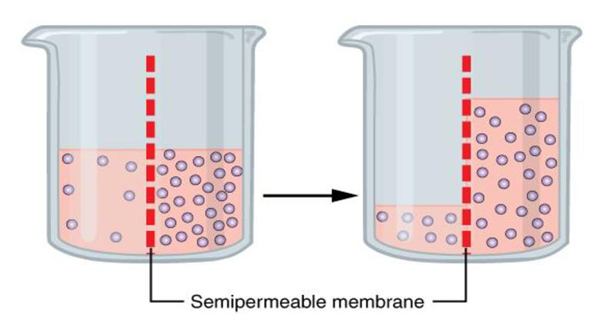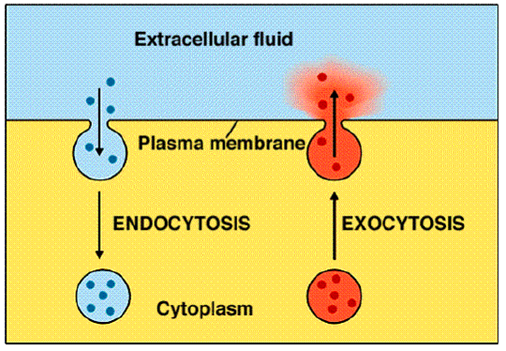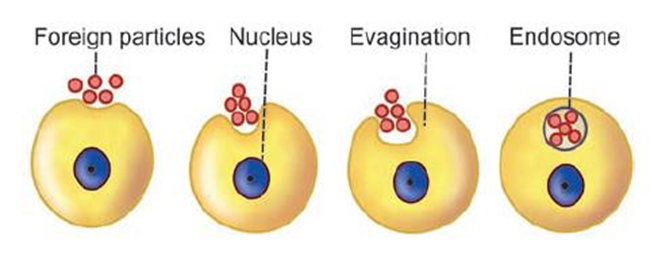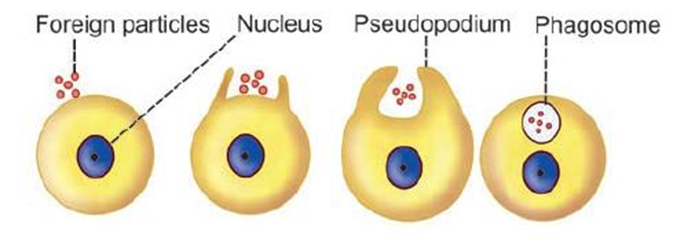TRANSPORT ACROSS CELL MEMBRANE
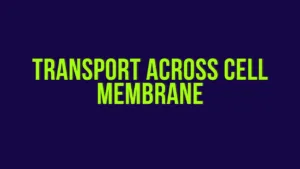
TRANSPORT ACROSS CELL MEMBRANE
Structure of the cell membrane is well suited for the transport of substances in and out of the cell.
Lipids and proteins of cell membrane play an important role in the transport of various substances between extra cellular fluid (ECF) and intracellular fluid (ICF).
Two types of basic mechanisms are involved in the transport of substances across the cell membrane:
1. Passive transport mechanism
2. Active transport mechanism.
1. Passive transport mechanism:
In passive processes, a substance moves down its concentration or electrical gradient to cross the membrane using only its own kinetic energy (energy of motion). Kinetic energy is intrinsic to the particles that are moving. There is no input of energy from the cell.
It is also known as diffusion or downhill movement.
Diffusion is of two types, namely simple diffusion and facilitated diffusion.
Simple diffusion of substances occurs either through lipid layer or protein layer of the cell membrane.
Facilitated diffusion occurs with the help of the carrier proteins of the cell membrane. Thus, the diffusion can be discussed under three headings:
Simple diffusion through lipid layer.
Facilitated or carrier-mediated diffusion.
Simple diffusion through lipid layer:
Simple diffusion is a passive process in which substances move freely through the lipid bilayer of the plasma membranes of cells without the help of membrane transport proteins. Nonpolar, hydrophobic molecules move across the lipid bilayer through the process of simple diffusion.
Such molecules include oxygen, carbon dioxide, and nitrogen gases; fatty acids; steroids; and fatsoluble vitamins (A, D, E, and K). Small, uncharged polar molecules such as water, urea, and small alcohols also pass through the lipid bilayer by simple diffusion.
Facilitated Diffusion or carrier-mediated diffusion:
Solutes that are too polar or highly charged to move through the lipid bilayer by simple diffusion can cross the plasma membrane by a passive process called facilitated diffusion. In this process, an integral membrane protein assists a specific substance across the membrane. The integral membrane protein can be either a membrane channel or a carrier. e.g. glucose, amino acids.
In addition to diffusion, there are some special types of passive transport, viz.
1. Bulk flow
2. Filtration
3. Osmosis
Filtration:
Movement of water and solutes from an area of high hydrostatic pressure to an area of low hydrostatic pressure is called filtration. Hydrostatic pressure is developed by the weight of the fluid. Filtration process
is seen at arterial end of the capillaries, where movement of fluid occurs along with dissolved substances from blood into the interstitial fluid. It also occurs in glomeruli of kidneys.
Osmosis:
Osmosis is the special type of diffusion. It is defined as the movement of water or any other solvent from an area of lower concentration to an area of higher concentration of a solute, through a semipermeable membrane.
The semipermeable membrane permits the passage of only water or other solvents but not the solutes.
Osmosis can occur whenever there is a difference in the solute concentration on either side of the membrane. Osmosis depends upon osmotic pressure.
Osmotic pressure is the pressure created by the solutes in a fluid.
Osmosis across the cell membrane is of two types:
1. Endosmosis: Movement of water into the cell
2. Exosmosis: Movement of water out of the cell.
2. Active transport mechanism:
Active transport is the movement of substances against the chemical or electrical or electrochemical gradient. It is like swimming against the water tide in a river. It is also called uphill transport. Active transport requires energy, which is obtained mainly by breakdown of high energy compounds like adenosine triphosphate (ATP).
Active transport is of two types:
1. Primary active transport
2. Secondary active transport
Primary active transport is the type of transport mechanism in which the energy is liberated directly from the breakdown of ATP. By this method, the substances like sodium, potassium, calcium, hydrogen and chloride are transported across the cell membrane. The most prevalent primary active transport mechanism expels sodium ions from cells and brings potassium ions in. Because of the specific ions it moves, this carrier is called the sodium-potassium pump.
Secondary active transport is the transport of a substance with sodium ion, by means of a common carrier protein. When sodium is transported by a carrier protein, another substance is also transported by the same protein simultaneously, either in the same direction (of sodium movement) known as symporters or in the opposite direction (known as antiporters). Thus, the transport of sodium is coupled with transport of another substance.
In addition to primary and secondary active transport systems, there are some special categories of active transport which are generally called the vesicular transport.
Special categories of active transport:
1. Endocytosis
2. Exocytosis
3. Transcytosis
1. ENDOCYTOSIS:
Endocytosis is defined as a transport mechanism by which the macromolecules enter the cell.
Macromolecules (substances with larger molecules) cannot pass through the cell membrane either by active or by passive transport mechanism. Such substances are transported into the cell by endocytosis.
Endocytosis is of three types:
Pinocytosis- Cell Drinking
Phagocytosis- Cell Eating
Receptor-mediated endocytosis
Pinocytosis:
Pinocytosis is a process by which macromolecules like bacteria and antigens are taken into the cells. It is otherwise called the cell drinking.
Pinocytosis involves following events:
Macromolecules (in the form of droplets of fluid) bind to the outer surface of the cell membrane
Now, the cell membrane evaginates around the droplets
Droplets are engulfed by the membrane
Engulfed droplets are converted into vesicles and vacuoles, which are called endosomes
Endosome travels into the interior of the cell
Primary lysosome in the cytoplasm fuses with endosome and forms secondary lysosome
Now, hydrolytic enzymes present in the secondary lysosome are activated resulting in digestion and degradation of the endosomal contents.
Phagocytosis:
Phagocytosis is the process by which particles larger than the macromolecules are engulfed into the cells.
It is also called cell eating.
Larger bacteria, larger antigens and other larger foreign bodies are taken inside the cell by means of phagocytosis. Only few cells in the body like neutrophils, monocytes and the tissue macrophages show phagocytosis. Among these cells, the macrophages are the largest phagocytic cells.
Mechanism of phagocytosis:
When bacteria or foreign body enters the body, first the phagocytic cell sends cytoplasmic extension (pseudopodium) around bacteria or foreign body
Then, these particles are engulfed and are converted into endosome like vacuole. Vacuole is very large and it is usually called the phagosome
Phagosome travels into the interior of cell
Primary lysosome fuses with this phagosome and forms secondary lysosome
Hydrolytic enzymes present in the secondary lysosome are activated resulting in digestion and degradation of the phagosomal contents
Receptor-mediated endocytosis:
Receptor-mediated endocytosis is the transport of macromolecules with the help of a receptor protein.
Surface of cell membrane has some pits which contain a receptor protein called clathrin. Together with a receptor protein (clathrin), each pit is called receptor-coated pit. These receptor-coated pits are involved in the receptormediated endocytosis
Mechanism of receptor-mediated endocytosis:
Receptor-mediated endocytosis is induced by substances like ligands
Ligand molecules approach the cell and bind to receptors in the coated pits and form ligandreceptor complex
Ligand-receptor complex gets aggregated in the coated pits. Then, the pit is detached from cell membrane and becomes the coated vesicle. This coated vesicle forms the endosome
Endosome travels into the interior of the cell. Primary lysosome in the cytoplasm fuses with endosome and forms secondary lysosome
Now, the hydrolytic enzymes present in secondary lysosome are activated resulting in release of ligands into the cytoplasm
Receptor may move to a new pit of the cell membrane.
Receptor-mediated endocytosis play an important role in the transport of several types of macromolecules into the cells, viz hormones, growth factors, lipids, antibodies.
2. EXOCYTOSIS:
Exocytosis is the process by which the substances are expelled from the cell. In this process, the substances are extruded from cell without passing through the cell membrane. This is the reverse of endocytosis.
3. TRANSCYTOSIS:
Transcytosis is a transport mechanism in which an extracellular macromolecule enters through one side of a cell, migrates across cytoplasm of the cell and exits through the other side.
Also, Visit:
B. Pharma Notes | B. Pharma Notes | Study material Bachelor of Pharmacy pdf


